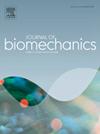Glenohumeral contact force, peak muscle forces, and thorax motion increase with fatiguing wheelchair propulsion in persons with a spinal cord injury
IF 2.4
3区 医学
Q3 BIOPHYSICS
引用次数: 0
Abstract
Shoulder problems are highly prevalent among manual wheelchair users with spinal cord injury, affecting their functioning and quality of life. This study investigates the impact of fatigue on wheelchair propulsion technique and shoulder loading in manual wheelchair users (MWU) with SCI. Twelve MWU with a paraplegia performed a standardized fatiguing wheelchair propulsion protocol; a biomechanical assessment of treadmill propulsion was obtained before and after the fatiguing protocol. Rate of perceived exertion (RPE), upper extremity kinematics, and wheelchair propulsion kinetics were assessed. Results showed increased RPE post-fatigue, with no significant changes in exerted forces but increased thorax forward lean and range of motion. Musculoskeletal modelling showed elevated glenohumeral joint contact force and muscle forces post-fatigue. These findings suggest a potential link between fatigue, altered propulsion technique, and increased shoulder loading, highlighting the risk of overuse injuries. Moreover, increased thorax motion during propulsion may indicate fatigue onset. Prospective cohort studies are warranted to validate the presented findings and explore the relationship between shoulder loading and injury risk. Understanding these dynamics can inform interventions to mitigate shoulder pain and enhance the well-being of MWU with SCI.
求助全文
约1分钟内获得全文
求助全文
来源期刊

Journal of biomechanics
生物-工程:生物医学
CiteScore
5.10
自引率
4.20%
发文量
345
审稿时长
1 months
期刊介绍:
The Journal of Biomechanics publishes reports of original and substantial findings using the principles of mechanics to explore biological problems. Analytical, as well as experimental papers may be submitted, and the journal accepts original articles, surveys and perspective articles (usually by Editorial invitation only), book reviews and letters to the Editor. The criteria for acceptance of manuscripts include excellence, novelty, significance, clarity, conciseness and interest to the readership.
Papers published in the journal may cover a wide range of topics in biomechanics, including, but not limited to:
-Fundamental Topics - Biomechanics of the musculoskeletal, cardiovascular, and respiratory systems, mechanics of hard and soft tissues, biofluid mechanics, mechanics of prostheses and implant-tissue interfaces, mechanics of cells.
-Cardiovascular and Respiratory Biomechanics - Mechanics of blood-flow, air-flow, mechanics of the soft tissues, flow-tissue or flow-prosthesis interactions.
-Cell Biomechanics - Biomechanic analyses of cells, membranes and sub-cellular structures; the relationship of the mechanical environment to cell and tissue response.
-Dental Biomechanics - Design and analysis of dental tissues and prostheses, mechanics of chewing.
-Functional Tissue Engineering - The role of biomechanical factors in engineered tissue replacements and regenerative medicine.
-Injury Biomechanics - Mechanics of impact and trauma, dynamics of man-machine interaction.
-Molecular Biomechanics - Mechanical analyses of biomolecules.
-Orthopedic Biomechanics - Mechanics of fracture and fracture fixation, mechanics of implants and implant fixation, mechanics of bones and joints, wear of natural and artificial joints.
-Rehabilitation Biomechanics - Analyses of gait, mechanics of prosthetics and orthotics.
-Sports Biomechanics - Mechanical analyses of sports performance.
 求助内容:
求助内容: 应助结果提醒方式:
应助结果提醒方式:


